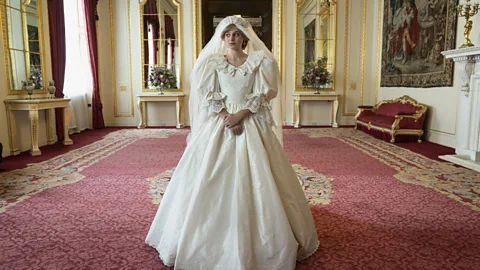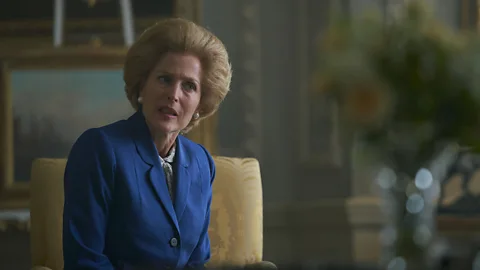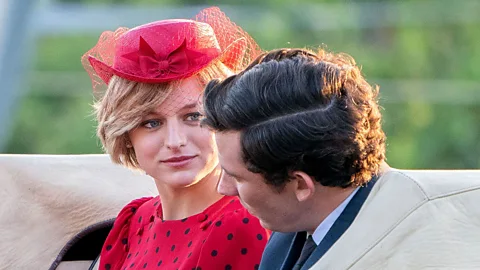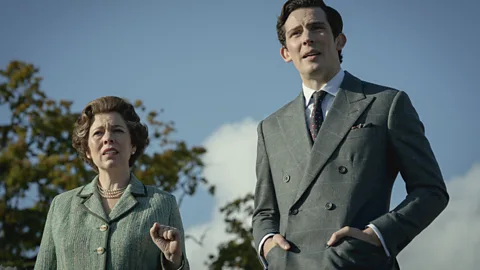The new series of The Crown is a ‘glorious spectacle’

Four stars for a series that is as much about ‘losing yourself’ in a lovingly created world as it is about ‘painting an absolute truth’, says Sarah Hughes.
The biggest surprise about series four of The Crown is that it doesn’t come preceded by a drum roll and the announcement: “And now ladies and gentleman, the moment you’ve all been waiting for – it’s time for the leading lady to take the stage.” Two leading ladies, in fact. This excellent season, a welcome return to form after the noticeable dip in quality last time around, introduces us to two very different women: Margaret Thatcher (Gillian Anderson), the first woman prime minister of the UK, and Lady Diana Spencer (newcomer Emma Corrin).
More like this:
As is only to be expected, Anderson makes her mark as the ambitious Thatcher early on, expertly capturing her odd blend of driven politician and 1950s housewife. Like Cate Blanchett’s recent turn as US conservative icon Phyllis Schlafly in Mrs America, it’s a performance that walks a fine line between persuasive characterisation and high camp (its arguable that these days it’s nearly impossible not to inject an element of the latter into any portrayal of Thatcher, so mythologised, hated and revered has she become) but Anderson gets away with it for two reasons.
 Des Willie/ Netflix
Des Willie/ NetflixThe first is that her portrayal of the increasingly embattled and unbending prime minister deepens as the series progresses to the point that even the most committed anti-Thatcherite might feel a small sliver of pity watching the blinkered vision that was once her greatest strength become her fatal weakness.
The second is the cleverly scripted scenes between Thatcher and Queen Elizabeth II (Olivia Colman). It’s no secret that the Queen had a complicated relationship with her first female prime minister, the two women sharing a sense of duty to the nation but having very different ideas of how that duty should be best expressed, and series’ creator Peter Morgan has a great deal of fun teasing out the different ways in which this power struggle unfolds.
It all eventually comes to a climax over Thatcher’s refusal to endorse sanctions against South Africa, a decision that would lead to an extraordinary breech of protocol that saw the Queen’s press secretary Michael Shea apparently confirm to the Sunday Times that government policies were causing the famously neutral Queen “some dismay”.
Yet while the episodes focusing on the relationship between Thatcher and the Queen are strong, they are arguably eclipsed by those dealing with Diana and her increasingly disastrous marriage to the Prince of Wales (Josh O’Connor again doing sterling work in an often difficult role).
 Netflix
NetflixDiana’s arrival in the royal family famously heralded a new and very different kind of royal celebrity and Morgan’s scripts and Corrin’s nuanced performance carefully unpick just how and why that came to be. From her first appearance dressed as ‘a mad tree’ at the family home, Corrin commands the screen, capturing both the young Diana’s gawky awkwardness and her desperate desire to be loved.
This is particularly true of what is probably the outstanding episode of the series, episode three’s Fairytale, which begins with Diana’s engagement to Charles and then follows the soon-to-be Princess of Wales through the six increasingly lonely weeks leading up to her wedding. It’s a beautifully paced hour of television, anchored by Corrin’s charisma – the scenes of Diana roller-skating around Buckingham Palace, Duran Duran playing on her Walkman, are both charming and very funny – and tempered by dark hints of difficulties to come.
Like Anderson’s, Corrin’s is a performance that only deepens as the series continues and we see Diana not only evolve as a style icon but, more importantly, begin to grasp the unique power that she possesses within the royal family, a power that can be wielded against them as much as for them.
None of this would work, however, if Morgan came down too firmly on one side of the Great Wales Marriage Debate. Instead he paints a sympathetic portrait of all three individuals involved, with the pragmatic Camilla Parker-Bowles (a smart and sexy Emerald Fennell) repeatedly shown to be far more suited to the set-in-his-ways Charles, while Charles himself, genuinely in love with Camilla, is clearly railroaded into a marriage he knows is all wrong even as he desperately tries to believe it could possibly work.
 Des Willie/ Netflix
Des Willie/ NetflixIt’s here that O’Connor’s performance truly comes into its own. He is wonderful at showing just how damaged Charles is by his childhood and lonely adolescence, how much he craves love and affection and how much, too, he is initially charmed by Diana. It’s a subtle turn and one that ensures that we both believe Charles when he makes an imioned declaration of love for Diana on the couple’s Australian tour, and never entirely lose sympathy for him even as he slowly retreats from his marriage and back into Camilla’s welcoming arms.
The rise and fall of Thatcher and the evolution of Diana might be the two biggest focuses of the season but there is also plenty to enjoy elsewhere. Colman’s Elizabeth is far less mannered this time around, with the actress tapping into the no-nonsense countrywoman at the Queen’s core – some of the series’ best scenes feature her striding around the countryside with Anne (an excellent Erin Doherty) discussing the family’s growing problems – while the standalone episode in which the weary Princess Margaret tries to come to with her fading beauty and declining life is a lovely showcase for Helena Bonham-Carter’s skills in addition to featuring the added bonus of a scene-stealing cameo from Tom Burke.
Fans can also rest assured that there’s nothing here as egregiously out-of-place as the bizarre Prince Philip Moon landing episode from last season, although one weak point is an episode in which the Queen decides to find out just who her favourite child is, despite decent turns from Angus Imrie as a petulant Prince Edward and Tom Byrne as a believably smug Prince Andrew.
There are, as always, liberties taken with the truth as well: an episode dedicated to Michael Fagan’s break-in at Buckingham Palace allows Morgan to make some pertinent if heavy-handed points about the effects of Thatcherism on wider society, while bearing little resemblance to the rather-more-roguish-in-real-life Fagan’s own of events. And for every bit of smart, sensitive dialogue, there is a bit where Morgan might as well spell out in neon letters that this isn’t just entertainment and ‘serious wider points about modern society’ are being made.
 Liam Daniel/ Netflix
Liam Daniel/ NetflixThese are minor misgivings, however, about a series that is as much about losing yourself in a fully-realised, lovingly recreated world as it is about painting an absolute truth. The Crown is always at its best when tackling the mythology of the Royal Family, both the ways in which we the public view the ‘fairytale’ and the ways in which ‘The Firm’ sell themselves. As we edge closer to the present day, that myth becomes ever more transparent, ensuring that The Crown pulls off the neat trick of being both a glorious spectacle in its own right and commenting astutely on the ways in which we use the Royal Family to sell a comforting story of our odd island nation around the world.
★★★★☆
The Crown will be streamed on Netflix from 15 November.
Love film and TV? BBC Culture Film and TV Club on Facebook, a community for cinephiles all over the world.
If you would like to comment on this story or anything else you have seen on BBC Culture, head over to our Facebook page or message us on Twitter.
And if you liked this story, sign up for the weekly bbc.com features newsletter, called The Essential List. A handpicked selection of stories from BBC Future, Culture, Worklife and Travel, delivered to your inbox every Friday.
